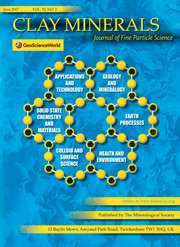Article contents
Soil composition and its influence on the engineering behaviour of fine-grained soils
Published online by Cambridge University Press: 14 March 2018
Abstract
Fifty per cent. of the soils studied came from the United States and represent samples from sites in which engineering difficulties were encountered; therefore, it is significant that the clay in 50% of all soils examined was an illite-smectite type, while illite-chlorite comprised 15% of the total. For illite-smectite clays, quantitative estimation of the illite and smectite percentages is obtained from the total potash and glycol retention data. The agreement between measured and calculated cation exchange capacities is taken as supporting evidence of the reliability of the methods used. The chlorite component in the illite-chlorite clays was a high-iron chlorite. Regular and random stratification of illite and chlorite components was observed. The most important influence of composition on behaviour is the very high water sensitivity of the expansive minerals. Most of the soils studied which had caused stability or volume change problems in the field contained expansive minerals. For soils with fines of a single mineral species or a simple mixture of minerals, predictions of behaviour can be made with fair accuracy from a knowledge of soil composition. Where the soil fines are interstratified minerals or cemented crystals, predictions can seldom be made with accuracy. Interstratification or cementation usually inhibits the water sensitivity of normally expansive minerals. This fact seriously limits the value of soil compositional data to the engineer.
- Type
- Research Article
- Information
- Copyright
- Copyright © The Mineralogical Society of Great Britain and Ireland 1957
References
- 5
- Cited by


